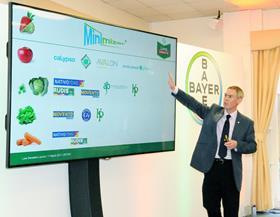
The launch this spring of a new strawberry fungicide, Luna Sensation from Bayer, will help towards the war on waste as it offers significantly better control of the fungi which cause disease problems in strawberries, according to the company.
Food waste occurs in the field, in the supply chain and in the home, and this waste has been estimated to add up to a staggering annual figure of 12 million tonnes. As part of the response to this, UK multiple retailers have pledged to cut food waste by 20 per cent by 2025 by signing the voluntary Courtauld 2025 agreement. And Bayer believes Luna Sensation will have an important role to play as it protects strawberries from disease not just in the field, but on the shelf too.
Speaking at the launch, Bayer’s fruit specialist Peter Newman said: “This is quite an event in our industry these days, and very welcome, to have a new fungicide for protected strawberries, a crop still growing in importance. The loss of plant protection products has brought more challenges to growers with the trend towards using everbearers to extend the season into the autumn and problems with humid conditions in plastic tunnels”.
Bayer campaign manager for horticulture, Tim Lacey, explained that the product’s enhancement of marketable yield comes largely from control of powdery mildew – which principally infects leaves – and extension of shelf life comes largely from activity against botrytis and soft rots – which principally affect fruit.
“In disease control trials Luna Sensation has shown significantly better control of powdery mildew than the established standard fungicide. It has also shown consistently stronger performance against botrytis than the previous standards as well as useful reductions in post-harvest soft rots.”
Plant pathologist Angela Berrie reported some encouraging results from a series of fruit rot trials at NIAB EMR. She pointed out that soft rots on ripe strawberries are caused by Mucor/Rhizopus (pin mould). Spores from soil or crop debris infect damaged fruit in warm, wet conditions and rot rapidly develops to fruit collapse within 24 hours.Mucor can grow as well at zero centigrade as at high temperatures.
These fungi can cause significant losses especially after harvest and are not so well controlled by fungicides. Also, although grey mould (botrytis) is generally well controlled by fungicides applied from flowering, and by cool chain management of fruit post-harvest, there is a need for a range of products as this fungus readily develops resistance to fungicides if not properly managed.
In two years of trials at East Malling Research, which included post-harvest assessments of individual strawberries, an experimental programme of five sprays of Luna Sensation gave the best control of botrytis and greatest reduction in soft rots.
Dr Stephen Humphreys, Bayer’s food chain manager, emphasised that 'the huge focus on reducing waste' meant that the launch of Luna Sensation was not just good news for growers wanting to reduce losses of fruit in the field, but spread throughout the food chain. A video showing three punnets of strawberries filmed over four and half days at ambient temperature shows that while the berries left untreated or with a standard fungicide programme deteriorated with rots over the time line, the Luna Sensation berries were still visually unaffected by rots until the end.
Like all crop protection companies Bayer faces lengthy phases of development and high costs to bring new chemistry to the market. This includes residue data to support registration within the EU but on top of this under the MiniMizer initiative, Bayer does additional trials with a food chain focus.
These are normally done following registration of a new product with commercial growers using commercial application equipment and to look at residue levels in typical use. However, Humphreys reported that even before Luna Sensation was approved Bayer was generating additional data looking at residues from positioning the two applications of the product in different parts of the spray program.
“The good news is the data showed that in those cases where a residue was detected it was only a fraction of the MRLs for the active substances in Luna Sensation: fluopyram 2mg/kg, trifloxystrobin 1mg/kg. Following the approval for Luna Sensation, Bayer will be working this season with a number of commercial growers to generate additional data for their MiniMizer initiative.”



